|
Getac 9213
A compact, light, full-function business-rugged notebook built for the road
By Conrad H. Blickenstorfer -- photography by Carol Cotton -- (view review as PDF)
The 9213 is a new "business-rugged" notebook computer from Getac. The company, founded in 1989 as a joint venture between Taiwan's MiTAC Technology Corporation and GE Aerospace, realized that an increasing number of corporate customers seek something more durable than garden-variety consumer notebooks without wanting the extra weight and cost of a fully rugged machine. This is exactly where the 9213 comes in. It offers everything one would expect from a modern "ultra-light," the category of notebooks that has a bigger screen, much more power, and many more features than a netbook, yet weighs hardly a pound more than one of those little pretenders.
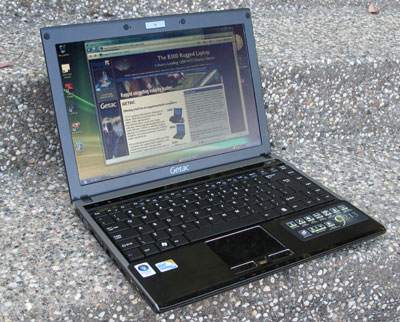 Introduced to the US market in July of 2009, the Getac 9213 is a very compact, elegant notebook computer with a wide-format 13.3-inch display, a frugal but powerful Intel Core 2 Duo SU9400 processor, an integrated DVD Super Multi drive and excellent connectivity, all in a package that is thinner and considerably lighter than the sleek 13-inch Apple MacBook. It's also just a quarter inch thicker and a few ounces heavier than the vaunted Apple MacBook Air, which has neither an internal optical drive nor the Getac's connectivity or inherent ruggedness. Introduced to the US market in July of 2009, the Getac 9213 is a very compact, elegant notebook computer with a wide-format 13.3-inch display, a frugal but powerful Intel Core 2 Duo SU9400 processor, an integrated DVD Super Multi drive and excellent connectivity, all in a package that is thinner and considerably lighter than the sleek 13-inch Apple MacBook. It's also just a quarter inch thicker and a few ounces heavier than the vaunted Apple MacBook Air, which has neither an internal optical drive nor the Getac's connectivity or inherent ruggedness.
The Getac 9213 was conceived as a business notebook that will not only survive the usual trials and tribulations that come with using a computer on the road and while traveling, but also perform flawlessly under all the conditions one might encounter when using a computer away from the desk. It is a machine for those who need full mobile computing power in a durable, handy package that does not compromise with a tiny screen with insufficient resolution, minuscule RAM, or lack of an optical drive. Based on our brief testing of a pre-production unit, the Getac 9213 meets all those requirements and then some. We consider it a potential home run.
What you get with the Getac 9213
What you get is a 12.5 x 9 inch notebook that's made by one of the world's premier vendors of rugged and durable computers, and one that just an inch thick and weighs 3.65 pounds, roughly half of your average notebook. You get a display that is large enough and has high enough resolution, a full-size keyboard so that your hands and fingers do not have to adjust to a slightly downsized version, brisk performance, and exceptional battery life.
Like today's cameras that usually have stickers on them with their primary selling points, the Getac 9213 comes with a label that lists its virtues. They are:
- The light weight (the label claims 3.1 pounds, but ours came in at 3.65—still very good).
- Resistance to liquids—rather than issuing an IP rating for the machine, you can spill 100cc of liquid onto the keyboard or keypad (about 3.5 ounces) and the machine will be fine.
- 45cm drop protection—that's actually only a foot and a half, somewhat curious as the 9212 with a 12.1-inch display is rated a more reassuring 2.5 feet.
- 120 kgf press resistance. Kilogram-force is not very well defined, but the idea is that the 9213 is quite crush-resistant.
- 8 hrs. Battery Life—we'll get to that farther down in the review.
- Fingerprint sensor—definitely a plus in a machine geared towards business!
- 60-Day Trial of MS Office—can do without that.
- Getac Utility—This refers to two very useful utilities, G-Manager and ECO setting. More on those later.
- Communication—WiFi and Bluetooth.
- Webcam—A 1.3 megapixel cam with a very good dual digital microphone array.
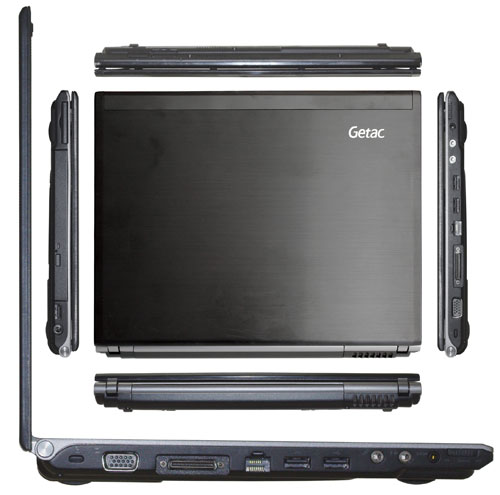 As you can see in the composite image to the right, the LED backlight allows for a very thin LCD case. The overall case is quite slender as well, and slightly wedge-shaped with four rubber feet. As you can see in the composite image to the right, the LED backlight allows for a very thin LCD case. The overall case is quite slender as well, and slightly wedge-shaped with four rubber feet.
Most of the connectivity is concentrated on the left side of the computer where you find two USB ports, a standard VGA connector, a docking/port replicator connector, an RJ45 LAN jack, audio in/out and a special S/PDIF interface for digital audio. S/PDIF stands for "Sony/Philips Digital Interconnect Format and can be used to connect to things like home theaters that support Dolby Digital or DTS sound. There's also a small lever to turn wireless on and off.
On the right side is the DVD Multi Drive, a third USB jack, power, and an ExpressCard/34 slot.
On the front is a 4-in-1 card reader that supports SD cards as well as Sony Memory Stick and Memory Stick Pro. Facing forward so that you can see them even when the LCD lid is closed are six control lights that show the status of wireless, AC/battery, battery charge, hard disk activity, caps lock and num lock.
The full-size 87-key keyboard has black keys with white writing for primary symbols and blue for the couple dozen function key operations (including a numeric keypad). The keyboard is well organized and provides good tactile feedback. Above the keyboard are three "Quick Buttons." They light up when you touch them and then slowly fade away. One launches Internet Explorer, one is user customizable, and one let you very quickly set the desired power savings mode. All indicator lights and icons are tiny and very faint. They certainly never get in the way.
The touchpad and mouse buttons have sort of a black mirror finish that looks very elegant, but can result in unwanted reflections.
The overall design theme of the Getac 9213 is matte-black, gloss-black and a bit of powdercoated silver. It's a very elegant combination and a very elegant, understated design. It also feels remarkably solid for such a light machine. The only drawback is the elegant matte-black brushed top of the computer is smudge and fingerprint prone.
Performance and battery life
In terms of performance, notebook computers generally require a compromise between performance and battery life. Faster processors need more power, which means a larger battery, which means higher weight. If prolonged use away from a power outlet is anticipated, a manufacturer will use a frugal processor that still delivers good performance. That is what Getac did by selecting the Intel Core 2 Duo SU9400, an ultra-low power dual core processor using state-of-the-art 45 nanometer lithography and running at 1.4GHz. Thermal design power (defined as the maximum amount of power a computer's cooling system needs to dissipate and used by Intel as a measure of power efficiency) is just 10 watts, only a fraction of what more desktop-oriented mobile processors use.
We benchmarked the Getac 9213's performance with Passmark Software's PerformanceTest 6.1 that runs about 30 tests covering CPU, 2D graphics, 3D graphics, memory, and disk and then computes scores for each category and an overall PassMark score. For comparison we added the results of Getac's own fully rugged B300 notebook as well as those of the semi-rugged Getac P470. The benchmark results show how it all fits together:
|
PERFORMANCE
|
Getac B300
|
Getac P470
|
Getac 9213
|
|
Processor
|
1.6GHz Core 2 Duo L7500
|
2.0GHz Core 2 Duo T7200
|
1.4GHz Core 2 Duo SU9400
|
|
Thermal Design Power
|
17 watts
|
35 watts
|
10 watts
|
|
CPU Mark
|
893.9
|
1085.2
|
838.4
|
|
2D Graphics Mark
|
158.5
|
295.2
|
176.0
|
|
Memory Mark
|
400.0
|
497.2
|
347.9
|
|
Disk Mark
|
343.3
|
277.8
|
390.2
|
|
3D Graphics Mark
|
138.3
|
154.8
|
102.0
|
|
Overall PassMark
|
420.8
|
498.0
|
402.9
|
As you can see, Despite its frugal nature, the Getac 9213's SU9400 processor provides very good performance. Anyone considering a Getac machine but wondering if performance might be much less than that of Getac's rugged notebook lineup will find that the new machine is remarkable quick, with benchmark performance within 5% of the B300 and 20% of the P470 despite its power-efficient processor and lower clock speed.
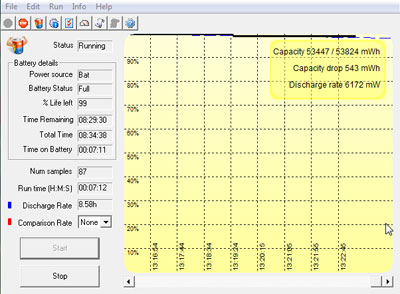 Now how about battery life? In the specifications on its website, Getac claims up to 12 hours of battery life for a system that is equipped with the optional secondary battery. The 9213's standard battery is a very compact 11.1 Volt/5,200mAH (57.7 watt-hour) Li-Ion pack that fits flush into the backside of the computer. That's a good supply of battery power for such a compact and light notebook and we eagerly awaited the results of our BatteryMon power drawdown test. Now how about battery life? In the specifications on its website, Getac claims up to 12 hours of battery life for a system that is equipped with the optional secondary battery. The 9213's standard battery is a very compact 11.1 Volt/5,200mAH (57.7 watt-hour) Li-Ion pack that fits flush into the backside of the computer. That's a good supply of battery power for such a compact and light notebook and we eagerly awaited the results of our BatteryMon power drawdown test.
As it turns out, idle drawdown is a very low 7.2 watts, and that is with all the default settings. With the brightness at its lowest (but still completely visible) setting and wireless off, we saw as little as 6.1 watts (see screen capture to the right). That is remarkable. Divide 57.7 watt-hours by 6.1 watts and you get almost 9.5 hours right there. Real world battery life, of course, depends on usage and operating conditions. Running resource-intensive applications such as video will use more power, but depending on power settings, the system will also go into stand-by and thus extend battery life.
As is, the Getac 9213 seems to be an exceptionally power-efficient system. In fact, of the dozen or so of Intel Atom-based systems we've benchmarked at RuggedPCReview.com, only one was able to draw less power at idle than the much more powerful Getac 9213. Six to eight hours of continuing operation ought to be possible on the main battery, and so the 12 hours claimed by Getac with the secondary battery installed seems achievable as well.
Excellent display
Sunlight-readability is rapidly becoming a major selling point in the rugged notebook sector. That makes sense as most rugged and semi-rugged notebooks will likely see outdoor duty, and it is just as important in business-rugged notebooks that may well be used outdoors at times. While most standard transmissive LCD displays wash out in daylight, the Getac 9213's does not. The picture below was taken on a very bright California summer day at about 10AM. The computer is sitting in partial shade and the picture is completely unedited.
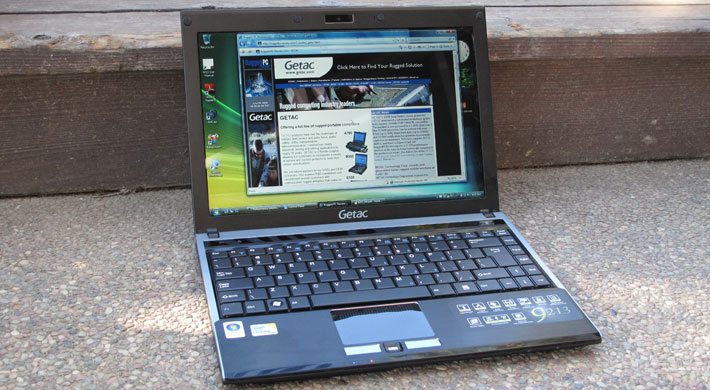
Though Getac does not specifically mention optical coating, a degree of coating must be there as the image remains very visible in direct sunlight. That, however, is only part of the story. While the 9213 does not have the superbright 1,200 nit backlight used on the company's B300 and V100 notebooks, the LED backlight is considerably brighter than what we usually see on consumer notebooks. Backlight brightness is controlled via a function key combination and goes from quite dim to full bright in 16 steps.
The picture below shows the 9213 directly facing the 10AM morning sun. This is the most challenging test for any LCD as no backlight can compete with the power of the sun. What matters in this situation is effective optical coating and polarizers. As you can see, the 9213 display remains visible and readable. The screen takes on a somewhat greenish cast and reflection can become an issue. It is actually not as much of a problem as you might expect as the human brain is very good at tuning out reflection and concentrating on the image itself.
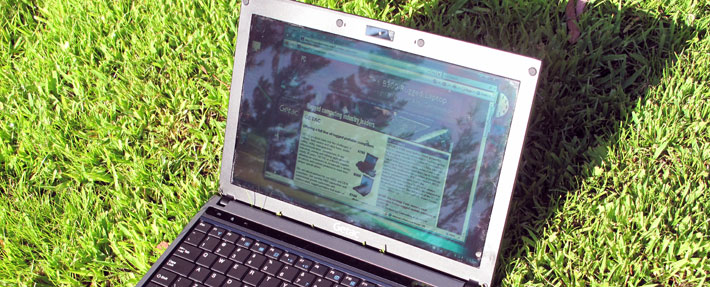
I didn't expect the 9213's display to be as good outdoors as it is. Almost all notebooks today have a glossy display surface that "pops" when viewed indoors, but often results in distraction reflections. The Getac 9213 both remains very readable outdoors, even in direct sunlight, and it also handles distracting reflections much better than most commercial consumer notebooks.
As far as viewing from different angles goes, the 9213's display has what appears a perfect 180 degrees viewing angle horizontally. The vertical viewing angle is significantly narrower, with the usual chromatic changes as you look at the screen from varying angles. That is about par for the course with most of today's notebook LCDs.
Getac Utility
Like most mobile hardware these days, the Getac 9213 comes with two separate utilities.
ECO (see screen shot below on the left) lets you manage the computer's power settings (balanced, high performance, power saver). You can also create profiles with Bluetooth and WiFi separately on or off.
G-Manager (see screen shot below on the right) shows system information in summary/graphics format for system, battery and various types of monitoring (CPU clock, load, voltage and temperature; fan speed; hard disk speed and free space; WLAN activity; as well as free physical and virtual RAM.

Security
Like most mobile hardware these days, the Getac 9213 offers various levels of hardware and software security to prevent unauthorized access as well as theft.
 The VitaKey one-touch identity protection software suite from EgisTec handles Fingerprint scanning. VitaKey works in conjunction with the 9213's fingerprint scanner, supports the Windows logon, and also multi-user logon scenarios. You can also create a "password bank" to protect websites and applications that need user names and passwords. VitaKey can handle file protection with encryption and decoding via fingerprint access, and you can also use the system to launch and protect applications. The VitaKey one-touch identity protection software suite from EgisTec handles Fingerprint scanning. VitaKey works in conjunction with the 9213's fingerprint scanner, supports the Windows logon, and also multi-user logon scenarios. You can also create a "password bank" to protect websites and applications that need user names and passwords. VitaKey can handle file protection with encryption and decoding via fingerprint access, and you can also use the system to launch and protect applications.
As part of its security, the Getac 9213 uses Trusted Platform Module (TPM) 1.2 hardware to create and manage computer-generated digital certificates. Combined with software, these certificates can be used to:
- Send and received secure email,
- Set up the browser for client identification,
- Sign Word macros,
- Encrypt individual files or entire folders, and
- Create secure network connections.
To use TPM, you have to enable TPM support in the BIOS and also install the TPM driver.
All of this can get pretty involved. Some users may never implement TPM or even passwords, whereas others may be set up in accordance with their company's IT security procedures, or they may configure an individual system for maximum security. The good news is that all the security tools are there.
Beyond all the electronic defense and protection measures, don't forget physical security and get a Kensington locking cable to use with the Kensington slot on the left side of the unit. It is inexpensive insurance against theft.
Ruggedness
Getac considers the 9213 a "business-rugged" computer capable of absorbing a degree of rough handling and demanding environmental conditions. The computer, of course, is quite light, but it's also tough and sturdy. There aren't any rubber bumpers that would add extra protection but also bulk. As is, the solid construction of the machine, the shock protection of the hard disk, and the shock-mounting of other sensitive components combine to let the machine survive drops from 2-1/2 feet when off and a foot and a half while operating.
As for environmental specs, the 9213 has an operating temperature range of 32 to 95 degrees Fahrenheit. So using it in freezing temperatures or desert climates is out. The computer can handle non-condensing humidity from 10 to 90%, and also the occasional liquid spill onto its keyboard or touchpad. The 9213 does not have an IP rating. As stated above, Getac also rates the 9213 as crushproof with a maximum of 265 pounds onto its surface and 33 pounds onto its thin LCD housing.
Getac also lists compliance with a variety of governing standards and regulations in various markets. These can be difficult to summarize in a review and they also vary depending on markets. Inquire with Getac.
Bottom line
The Getac 9213 is for those who need a full-function notebook to take with on the road and other places that include traveling and the occasional drop or spill. Further, it's for those who want for their computer to be light and handy, but still offer a display large enough to do real work on. The 9213 fills those requirements in a package that measures 12.5 x 9 inches, is just an inch thick, and weighs only 3.6 pounds.
 Unlike netbooks, the Getac 9213 neither compromises performance nor functionality. Its efficient yet powerful 1.4GHz Intel Core 2 Duo SU9400 processor provides speed and responsiveness very close to that of Getac's larger rugged and semi-rugged computers. You also get adequate onboard ports and connectivity as well as quick SATA disks up to 250GB and a flexible media bay with a DVD Super Multi drive. There is plenty of onboard security, including a fingerprint scanner. An integrated 1.3 megapixel camera allows video conferencing. Unlike netbooks, the Getac 9213 neither compromises performance nor functionality. Its efficient yet powerful 1.4GHz Intel Core 2 Duo SU9400 processor provides speed and responsiveness very close to that of Getac's larger rugged and semi-rugged computers. You also get adequate onboard ports and connectivity as well as quick SATA disks up to 250GB and a flexible media bay with a DVD Super Multi drive. There is plenty of onboard security, including a fingerprint scanner. An integrated 1.3 megapixel camera allows video conferencing.
The frugal processor, LED backlight, properly sized battery, and efficient design of the 9213 make for excellent battery life.
In terms of wireless communications, there's Bluetooth and an integrated Intel WiFi Link 5300 module supports 802.11a/b/g/draft-n.
The 9213 comes with a bright 13.3-inch display that uses the "wide" 1280 x 800 pixel format with a 16:10 aspect ratio. Thanks to very effective optical coatings and filters, the screen offers excellent sunlight viewability with only modest reflections.
Overall, the Getac 9213 is a smartly designed business-rugged machine that offers full commercial notebook functionality and long battery life in an elegant, lightweight package that is far more durable and able to handle the occasional spill and drop. The price of a fully equipped 9213 is US$1,799, considerably more than a consumer notebook, but a downright bargain considering its Getac pedigree, long 3-year warranty, and sturdy build quality.
-- Conrad H. Blickenstorfer
Getac 9213 Specs:
| Type |
Business-rugged notebook
|
| Processor |
Intel Core 2 Duo SU9400 with 3MB L2 cache (TDP 10 watts)
|
| CPU speed |
1.4 GHz, 800 MHz FSB
|
| Chipset |
Intel GS45 + ICH9M-SFF
|
| Video Controller |
UMA |
| OS |
Windows XP, Vista Business, or Windows 7
|
| Memory |
1GB/3GB DDR2 |
| Display |
13.3-inch/1280x800 pixel sunlight-viewable TFT with LED backlight |
| Digitizer |
None |
| Keyboard |
Integrated, full-scale, waterresistant |
| Storage |
2.5-inch SATA 160 to 250GB
|
| Expansion slots |
1 Express Card 34/54mm, 4-in-1 card reader (MMC, SD, MS, MS-PRO)
|
| Housing |
Magnesium alloy chassis |
| Size |
12.5 x 9.0 x 1.0 |
| Weight |
3.625 lbs. with battery as tested
|
| Operating temperature |
32 to 95 Fahrenheit |
| Ingress protection |
unknown |
| Drop |
1.5 feet |
| Vibration/shock/other |
NA |
| Power |
Li-Ion (11.1V, 5,200mAh; 57.7 watt-hours), optional 27 watt-hour media bay battery ("up to 12 hours") |
| Interface |
3 USB 2.0, RJ11, gigabit RJ45, dock/port replicator, audio in/out, S/PDIF, VGA video, 1.3mp camera, fingerprint scanner |
| Wireless options |
Intel WiFi Link 5300 802.11a/b/g/draft-n WiFi; Bluetooth 2.1 + EDR
|
| Price |
US$1,799 (3GB RAM, 160GB drive, 3 year warranty) |
| Contact |
Getac us.getac.com |
(copyright 2009 RuggedPCReview.com)
|












